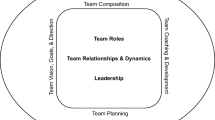Abstract
Higher education institutions (HEIs) worldwide have been undergoing significant levels of structural change for a number of years, ranging from minor re-alignments of roles and responsibilities to radical changes such as the creation of new roles and new models of operating. This article discusses some initial findings from a recent UK-focused research project that investigated the challenges and changes associated with the composition of “top management team” (TMT) structures in HEIs. Using the key findings from desk research and empirical investigation in a sample of UK institutions, the article identifies some of the key changes in the roles and responsibilities of the TMT, and identifies examples of good “practice” or “process’ within institutions.
Similar content being viewed by others
References
Ancona, D., & Nadler, D. (1989). Top hats and executive tales. Sloan Management Review, 31(1), 19–28.
Bensimon, E.M., & Neumann, A. (1993). Redesigning collegiate leadership: Teams and teamwork in higher education. Baltimore: The Johns Hopkins University Press.
Carmeli, A., & Schaubroeck, J. (2006). Top management team behavioural integration, decision quality and organisational decline. The Leadership Quarterly, 17(5), 441–453.
Clark, B. (1998). Creating entrepreneurial universities: Organizational pathways of transformation. Oxford: Pergamon Press.
Finkelstein, S., & Hambrick, D. (1996). Strategic leadership: Top executives and their effects on organisations. St Paul, MN: West Publishing.
Gioia, D.A., & Thomas, J.B. (1996). Identity, image and issue interpretation: Sensemaking during strategic change in academia. Administrative Science Quarterly, 41(3), 370–403.
Hambrick, D.C. (1994). Top management groups: A conceptual integration and reconsideration of the ‘team’ label. In B.M. Staw & L.L. Cummings (Eds.), Research in organizational behaviour (pp. 171–214). Greenwich, CT: JAI Press.
Hambrick, D.C. (1995). Fragmentation and the other problems CEOs have with their top management teams. California Management Review, 37(3), 110–126.
Herb, E., Leslie, K., & Price, C. (2001). Teamwork at the top. McKinsey Quarterly, 2001(2), 32–43.
Jarzabkowski, P. (2003). Strategic practices: An activity theory perspective on continuity and change. Journal of Management Studies, 40(1), 23–55.
Jarzabkowski, P., & Searle, R.H. (2004). Harnessing diversity and collective action in the top management team. Long Range Planning, 37(5), 399–419.
Jarzabkowski, P., & Wilson, D.C. (2002). Top teams and strategy in a UK university. Journal of Management Studies, 39(3), 355–381.
Lambert, R. (2003). Lambert review of business-university collaboration. London: HMSO.
McNay, I. (1995). From the collegial academy to corporate enterprise: The changing cultures of universities. In T. Schuller (Ed.), The changing university? (pp. 105–115). Buckingham: SRHE and Open University Press.
Middlehurst, R. (2004). Changing internal governance: A discussion of leadership roles and management structures in UK universities. Higher Education Quarterly, 58(4), 258–279.
Porter, M.E., Lorsch, J.W., & Nohria, N. (2004). Seven surprises for new CEOs. Harvard Business Review, 82(10), 62–72.
Shattock, M. (1970). A changing pattern of university administration. Universities Quarterly, 24(3), 310–320.
Sloman, A. (1964). A university in the making. London: British Broadcasting Corporation.
Taylor, J. (2006). ‘Big is beautiful.’ Organisational change in universities in the United Kingdom: New models of institutional management and the changing role of academic staff. Higher Education in Europe, 31(3), 251–273.
Whitchurch, C. (2004). Administrative managers—A critical link. Higher Education Quarterly, 58(4), 280–298.
Whitchurch, C. (2006). Who do they think they are? The changing identities of professional administrators and managers in UK higher education. Journal of Higher Education Policy and Management, 28(2), 159–171.
Wiersema, M.F., & Bantel, K.A. (1992). Top management team demography and corporate strategic change. Academy of Management Journal, 35(1), 91–121.
Author information
Authors and Affiliations
Corresponding author
Rights and permissions
About this article
Cite this article
Woodfield, S., Kennie, T. Top Team Structures in UK Higher Education Institutions: Composition, Challenges, and Changes. Tert Educ Manag 13, 331–348 (2007). https://doi.org/10.1080/13583880701535521
Published:
Issue Date:
DOI: https://doi.org/10.1080/13583880701535521




